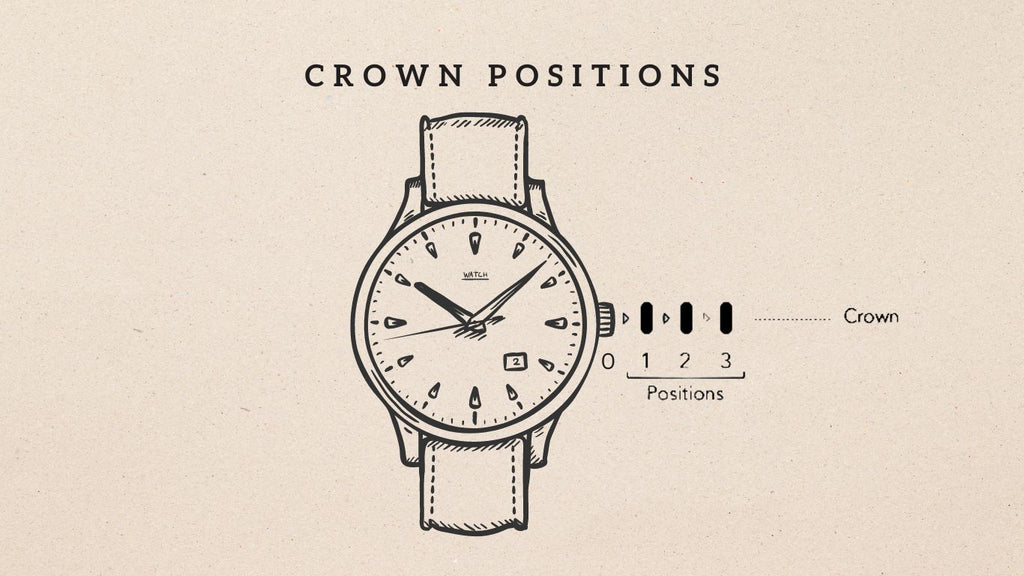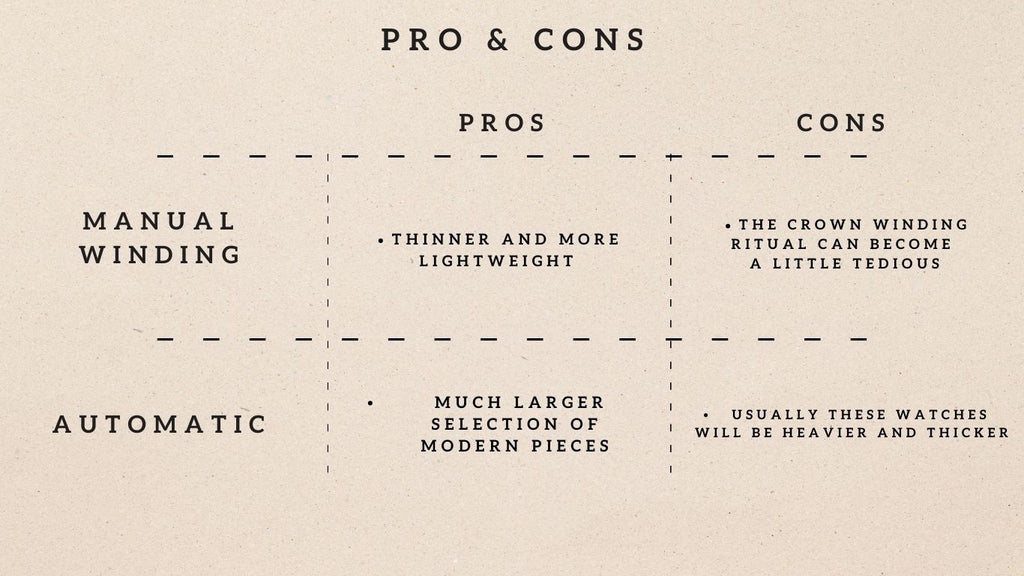So wickeln Sie eine automatische oder handgewandte Uhr: Ein Leitfaden zum Laufen Ihrer Rolex-Uhr.
Dazu zählen fast alle Rolex Modelle, außer Ein Modell namens Austernquarz das eine Batterie als primäre Energiequelle verwendet.
Wenn wir jedoch auf die Mehrheit der Rolex-Uhren zurückkommen, die keine Batterie benötigen, können wir feststellen, dass sie in zwei große Kategorien unterteilt werden: automatische und handaufgezogene mechanische.
In diesem Artikel erklären wir, wie man eine Uhr mit Automatik- oder Handaufzug aufzieht.
Für die Automatikuhren, das Uhrwerk – das Herz und die Seele der Uhr – wird durch die Energie angetrieben, die durch die Bewegungen Ihres Handgelenks beim Tragen erzeugt wird.
Das Geheimnis beider Uhrwerke liegt jedoch in der „Krone“, wie wir in diesem Artikel sehen werden.

Wie funktioniert eine Automatikuhr?
Ein automatisches Uhrwerk arbeitet mit einem Rotor, der innerhalb der Uhr hin und her schwingt, um ihre Funktionalität aufrechtzuerhalten. Dieser Rotor wird durch die Bewegung Ihres Arms aktiviert und zieht die Uhr effektiv auf, während Sie sie tragen.
Bleibt die Uhr längere Zeit unbewegt, wird der automatische Uhrwerksbetrieb gestoppt.
Wie also tue ich eine Automatikuhr aufziehen?
Eine Automatikuhr funktioniert, wie ihr Name schon sagt – sie zieht sich automatisch auf. Beim ersten Tragen muss sie jedoch manuell aufgezogen werden, um den internen Mechanismus in Gang zu setzen.
Um dies zu tun, Gehen Sie folgendermaßen vor:
1) Nehmen Sie die Uhr vom Handgelenk ab. Versuchen Sie nicht, sie aufzuziehen, während Sie sie tragen.
2.1) Für eine herkömmliche Automatikuhr: Schrauben Sie die Krone bis auf Position 1 heraus. Drehen Sie die Krone anschließend vorsichtig etwa 30 Mal im Uhrzeigersinn, bis Sie einen Widerstand spüren.
2.2) Für sportliche Automatikuhren mit verschraubter Krone für erhöhte Wasserdichtigkeit: Schrauben Sie die Krone zunächst drei- oder viermal gegen den Uhrzeigersinn auf, bis sie herausspringt. Drehen Sie die Krone dann etwa 30 Mal im Uhrzeigersinn, um sie anzutreiben.
3) Überprüfen Sie als Nächstes die Datumsanzeige. Wenn Ihre Uhr aufgezogen werden muss und ein Datumsfenster hat, zeigt sie wahrscheinlich ein falsches Datum an. Ziehen Sie die Krone einmal aus der Aufziehposition in Position 2 heraus und drehen Sie sie im Uhrzeigersinn, um das Datum einzustellen.
Wir raten davon ab, das Datum einzustellen, wenn sich die Uhrzeiger in der Nähe der 12-Uhr-Position befinden, um eine mögliche Beschädigung des Datumsmechanismus zu vermeiden.
4) Stellen Sie die Uhrzeit ein, indem Sie die Krone erneut in Position 3 herausziehen und entweder im oder gegen den Uhrzeigersinn drehen.
5) Stellen Sie sicher, dass die Krone wieder fest eingeschraubt ist, wenn Sie eine verschraubte Krone haben. Bringen Sie dazu die Krone in die Aufzugsposition zurück, drücken Sie sie noch einmal hinein und beginnen Sie dann, sie im Uhrzeigersinn zu drehen, um sie zu befestigen.
6) Sie sind fertig!
Versuchen Sie, die Uhr jeden Tag zu tragen oder legen Sie sie auf einen Uhrenbeweger, damit Sie diese Schritte nicht wiederholen müssen.
A mechanisch mit Handaufzug betrachtenmuss unterdessen aufgezogen werden, um der Antriebsfeder die Energie zum Weiterdrehen der Zahnräder zu geben.
Wie also tue ich eine Hand aufziehen mechanische Uhr aufziehen?
Nehmen Sie die Uhr ab, suchen Sie die Krone und halten Sie sie zwischen Daumen und Zeigefinger fest. Drehen Sie es 20–40 Mal im Uhrzeigersinn.
Sie spüren den Widerstand und erreichen bei einer Uhr mit Handaufzug einen Punkt, an dem sich die Uhr nicht mehr aufziehen lässt.
Dann kann es losgehen!
Wenn Sie stattdessen Datum/Uhrzeit einer Handaufzugsuhr ändern möchten, gehen Sie folgendermaßen vor:
1) Drehen Sie die Krone im Uhrzeigersinn. (Kronenposition 0)
2) Datum einstellen: Krone gegen den Uhrzeigersinn drehen. (Kronenposition 1)
3) Stellen Sie die Uhrzeit ein: Drehen Sie die Krone gegen den Uhrzeigersinn. (Kronenposition 2)
Ein bisschen von seiner Geschichte:
In 1931 erfand Rolex den Perpetual-Rotor – der erste Mechanismus mit automatischem Aufzug der Welt. Der Begriff „Perpetual“ bezieht sich auf die Fähigkeit, mit der Energie zu laufen, die durch die Bewegung des Handgelenks des Trägers erzeugt wird.
Die Rotoren oder Metallgewichte schwingen frei im Inneren der Uhr, während Sie sie tragen. Durch die Bewegungen Ihrer Hand drehen sich die Rotoren, die wiederum die Hauptfeder aufziehen, und so wird die Uhr automatisch angetrieben.
Welche Vorteile haben mechanische Uhren gegenüber batteriebetriebenen Quarzuhren?
Mechanische Uhren werden für ihre komplexe Handwerkskunst geschätzt.
Ihre Uhrwerke sind mit aufwendigen Mechanismen aus Zahnrädern, Federn und Hemmungen gefertigt und zeugen von der Kunstfertigkeit und Präzision der feinen Uhrmacherei.
Diese akribische Liebe zum Detail führt zu den aufwendigen Designs und der optisch ansprechenden Ästhetik mechanischer Uhren.
Darüber hinaus weckt das Aufziehen einer Uhr oder das Erleben des rhythmischen Tickens eine tiefe Wertschätzung für die Geschichte und Tradition der Uhrmacherei.
Darüber hinaus werden mechanische Uhren durch das Aufziehen einer Antriebsfeder angetrieben (oder bei automatischen Uhrwerken durch die natürliche Bewegung des Handgelenks des Trägers). Daher sind sie nicht auf Batterien angewiesen, wodurch ein häufiger Batteriewechsel entfällt, der bequem und umweltfreundlich.
Mechanische Uhren werden wegen ihrer Handwerkskunst, Tradition und Nachhaltigkeit geschätzt.
